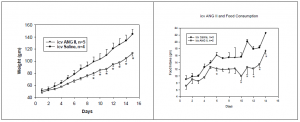Jared Anderson and Dr. James Porter, Zoology
Objective
In the United States obesity and its associated harmful effects are major health concerns which have received considerable attention by researchers. Studies have been performed in an attempt to discover the physiological mechanisms involved with food intake and weight loss. A few of these previous studies have shown that a hypothalamic peptide, corticotropin-releasing hormone (CRH) plays an important role in regulating food intake. It has also been shown that CRH acts on specific receptors of the ventromedial hypothalamus and thus causes a cascade of anorectic neuropeptides and proteins responsible for a decrease in food intake and body weight. A significant weight loss is seen in the cases where CRH has been artificially increased. However, the physiological mechanisms which cause this increase of CRH have not yet been determined. Preliminary cardiovascular-related experiments done by Dr. James Porter on rats unexpectedly showed that an increase of brain Angiotensin II (ANG II) also plays a role in decreasing body weight, although food intake was not measured in those studies. CRH-secreting cells within the hypothalamus are known to express ANG II receptors.
Hypothesis
The hypothesis of this project is that the central action of ANG II in the hypothalamus stimulates an increased production of CRH, and thus plays a role in the physiologic pathway which leads to decreased food intake and body weight. To verify this hypothesis we performed experiments to determine the role ANG II plays in regulating food intake and body weight.
Procedure
Food intake and body weight were determined in two groups of young rats (3-4 weeks). Group 1, a control group of rats (n=10) received intracerebroventricular (ICV) infusion of saline over a two week period. Group 2, (n=10) received a two week ICV infusion of ANG II (1μg/hr). The chronic ICV infusions were delivered by osmotic minipumps (implanted subcutaneously and connected to ICV cannulae) at a rate of .5μg/hr.

Throughout a two week interval, the rats’ body weight and food intake was measured and recorded daily. A considerable decrease in the body weight and food intake of the rats of Group 2 compared to those of Groups 1 was observed (as shown in the graphs on the following page) where the differences becoming significantly different after day 6.

In addition to the differences in body weight and food intake, the nose-anus length of the ANG II infused rats was significantly decreased (15.8 ± 0.2 vs 16.5 ± 0.2). Hypothalamic CRH mRNA (found through RT-PCR) tended to be higher in the ANG II infused rats (1.0 ± 0.28 vs 0.66 ± 0.37 CRH O.D./18S O.D.) but not significantly. These data show that ANG II has a central effect to decrease food intake and body weight in young rats. The mechanism for the effect could be increased expression of hypothalamic anorexic peptides.
This data will be published from an abstract prepared by J. P. Porter and J. M. Anderson entitled, Chronic Icv Infusion of ANG II Decreases Food Intake and Weight Gain in Young Rats, which will be presented in November 2000 at a Science Convention in New Orleans.
References
- Cassis, Lisa A., Dana E. Marshall, Michael J Fetinger, Brady Rosenbluth, and Robert A. Lodder. Mechanisms contributing to angiotensin II regulation of body weight. The American Physiological Society E867-E876, 1998.
- Brink, Marijke, Jason Wellen, and Patrick Delafontaine. Angiotensin II Causes Weight Loss and Decreases Circulating Insulin-like Growth Factor I in Rats through a Pressor-independent Mechanism. The American Society for Clinical Investigation, Inc. Vol. 97, Number 11, 2509- 2516, 1996.
